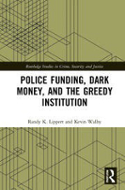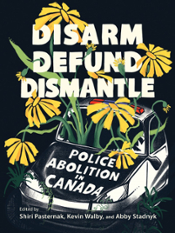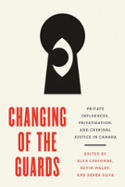Three new books for CJ prof!
Wed. Jun. 1, 2022
Congratulations to Kevin Walby, Associate Professor in the Department of Criminal Justice, on the publication of three new books!

One of these, Police Funding, Dark Money, and the Greedy Institution (Routledge, 2022), Dr. Walby co-authored with Randy K. Lippert. It emerged from work on two SSHRC-funded projects.
The second, Changing of the Guards: Private Influences, Privatization, and Criminal Justice in Canada (UBC Press, 2022), Dr. Walby co-edited with Alex Luscombe and Derek Silva.
 And the third, Disarm, Defund, Dismantle: Police Abolition in Canada (BTL Press, 2022), Walby co-edited with Shiri Pasternak and Abby Stadnyk. It is a volume of compelling essays contributed by academics and activists. Recently I met with Dr. Walby to speak with him about the book and the movement to abolish the police in Canada. The following is a summary of that conversation.
And the third, Disarm, Defund, Dismantle: Police Abolition in Canada (BTL Press, 2022), Walby co-edited with Shiri Pasternak and Abby Stadnyk. It is a volume of compelling essays contributed by academics and activists. Recently I met with Dr. Walby to speak with him about the book and the movement to abolish the police in Canada. The following is a summary of that conversation.
I want to start by asking about the term “police abolition” and how the book came about?
Walby explains that academics and activists came together in response to the police killings of George Floyd in Minneapolis, Eishia Hudson in Winnipeg, and many other Indigenous and Black people in the spring of 2020, early in the COVID-19 pandemic. Dr. Walby says the book came about in a way that was “collective and organic” where “academics and activists wanted to contribute in book form.”
Police abolition, says Walby, is a term that Black Feminist scholars in the US have been using in their writings for decades. In our society, police are tasked with addressing harm and transgressions. However, he states, police services, funded with public money, are reactive and are not highly effective. This is evident, he says, where the rate of transgression increases even though the funding to police services continues to increase. Police abolition, then, is “a movement which seeks to invest public funds in alternative measures, such as antiviolence training for young men and in community response teams that would work proactively to reduce transgression, rather than sending police after the fact and incarcerating people.”
Shiri Pasternak and Abby Stadnyk co-edited the book with you. What strengths did they bring to it?
Both Pasternak and Stadnyk, Walby says, are scholars in this area who have experience as activists organizing events and have written about abolition and are therefore “able to bridge the two worlds.
I am interested in the artwork on the book cover. Whose work is it, and was does it represent?
Walby explains that a Toronto artist, Amber Williams-King was commissioned to provide the cover art. He states that Williams-King is skilled at using cartoons and graphics to represent scholarly work. The image, as he sees it, represents the way we can reach a healthy, safe society provided that “we reprioritize the way we spend public money and reduce funding to social control agencies.” People, he says, “are struggling, suffering, and feeling distress. There is visible poverty in our society and yet decisions continue to be made which fund police and street repairs, instead of addressing poverty and providing mental health supports.”
Several of the chapter titles speak to the determination of communities to deal with issues on their own (and to help other communities in doing so). Can you talk about one these, e.g., Chapter 13, “DIY Defunding the Police: How Winnipeg Sex Workers Stopped the Police from Taking Drivers’ Money” by the Sex Workers Action Coalition of Winnipeg?
According to Walby, sex workers have long felt that police do not protect them. Instead, they feel they have to protect themselves from clients who are aggressive and from police. In a theme that runs through the book, Walby says, communities such as the Sex Workers of Winnipeg Action Coalition have a found ways to provide for their own safety, for example with bad date reporting.
Walby maintains that community-based safety strategies, such as those described in Chapter 13 and elsewhere in the book, have been effective and provide something to build on in a move toward abolition. The argument is this: “If it’s possible for communities to organize to keep themselves safe, then surely it should be possible to respond to calls without guns and tasers.” Walby acknowledges that there will be still be calls where there is violence, but emphasizes that,”according to police statistics, only 9 to 12% of police calls actually involve violence.”
What are some of the movements toward change that are discussed in the book?
Walby lists several movements for justice, as follows, and points out these “intersect” with one another:
- Police and prison abolition.
- Social workers who are abolitionists.
- Migrant/immigrant justice networks, which focus on migrant detention and migrant labour.
- Groups mobilizing for Indigenous sovereignty have long been aware than police are a colonial institution which have a history going back centuries of perpetrating violence against them. The Idle No More movement is one example, but Indigenous land defenders and water protectors, he says, have long been fighting the harm done to Indigenous people by police.
- Racial justice movements, such as the Black Lives Matter movement.
Is there a single most important thing you learned while working on this book?
Walby says that he was particularly struck by two things:
- The number of people who have experienced or who have family members who have experienced criminalization, and
- How vigorously police are fighting back against calls to defund the police by:
- Threatening to cut diversity funding,
- Claiming to be the only way to create safe neighbourhoods, and
- Coopting claims that are critical of police responses and turning these into opportunities to increase funding to police. As an example, Walby cites the police response to the death of Chantel Moore. Ms. Moore was killed by police during a “wellness check” in Edmundston, New Brunswick in 2020. RCMP made a case for needing additional resources and are getting body worn cameras and tasers.
Finally, does this relate to the use of the term “dark money,” or secretive funds that are difficult to trace, as the new book that you co-authored with Randy K. Lippert, Police Funding, Dark Money, and the Greedy Institution (Routledge, 2022)?
Dr. Walby states that there are a few ways that funding to police can be conceived as “dark money,” such as:
- Funds to police foundations are used for costs related to increased militarization of the police, e.g., SWAT team gear, surveillance equipment
- Funds paid for special duty policing at sporting events are being paid privately by corporations, and
- Even public funding is “dark,” he says, in the sense there is so little public input into the way the police budget unfolds.

